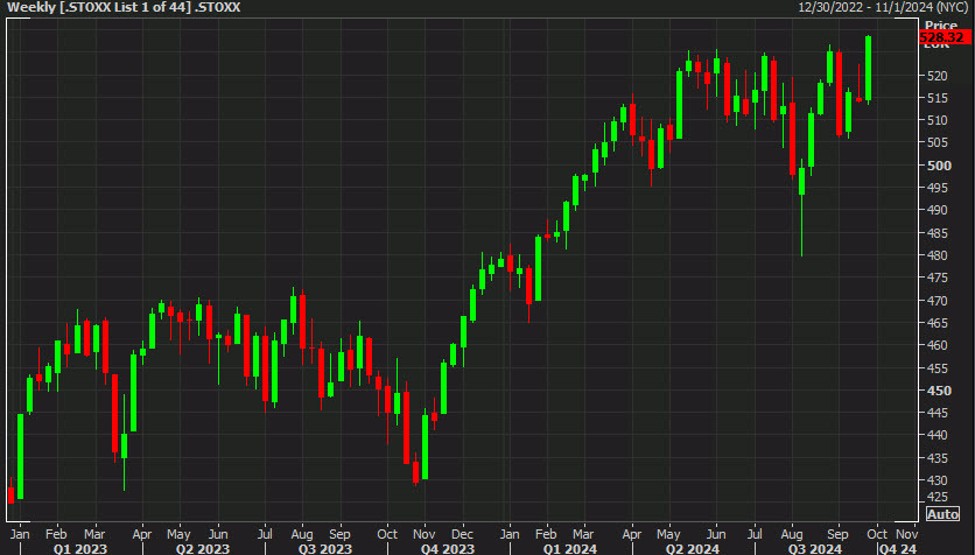CatLane/E+ via Getty Images
Investment Environment
The U.S. economy is a global standout among developed markets. While other nations/economies are reporting anemic growth, the U.S. continues to expand. The latest read (third estimate) for first quarter growth is a respectable 1.4% and estimates are for 1.5-2.0% in the second. The employment picture remains healthy with the most recent (May) jobs report coming in much stronger than expected registering a gain of 272,000. The May CPI report was a positive indicator that inflation may have peaked in 1Q:24. Auto insurance, which was up 20%+ over the last twelve months, slipped 0.1% in May. Grocery prices were flat, clothing prices fell outright, and air fares and gas prices dropped nearly 4% in time for the summer travel season. The Core PPI reading was flat versus consensus of 0.3%. Coming after this softer than expected inflation data, May retail sales rose a mere 0.1% m/m versus expectations for 0.3%, and prior months were revised lower. Spending at restaurants and bars declined -0.4% suggesting a more discerning and perhaps strained consumer. With 1Q:24 earnings season complete, per UBS, S&P 500 (SP500,SPX) companies’ revenues grew nearly 4% and EPS (including buybacks) were up 10%, both better than expected.
While the U.S. is facing a housing shortage (per Zillow, the nation is short of 4.5 million homes based on population trends), elevated mortgage rates pushed down housing starts and new home sales in May. Higher rates have also impacted companies’ willingness to invest as the May Institute for Supply Management (‘ISM’) purchasing manager’s index (‘PMI’) came in below expectations and remains in contraction territory. The services PMI, on the other hand, rose back to expansion registering 53.8 (after contracting in April for the first time since December 2022).
The Bank of Canada cut its target rate by 25 bps to 4.75% while the next day the ECB followed suit. All of Eurozone’s flash PMIs unexpectedly weakened in June, both manufacturing and services, yet inflation remains a concern. The Swiss National Bank lowered borrowing costs for the second time this year as its inflation gauge has dropped to less than 2% and its currency has appreciated, hurting exports. The Bank of England elected to keep rates unchanged in advance of their upcoming election despite headline inflation dropping to its 2% target in May. Economic difficulties led to the political right’s recent outperformance in the European Parliament election and subsequent French call for snap election. Brussels’ pressure on EU members to rein in spending, with potential penalties for not complying, is another hit to the zone’s confidence.
The FOMC similarly made no move on rates at its June meeting. While Fed Chair Powell said, “April and May data suggest we are getting back on a disinflationary path,” Federal Reserve (Fed) officials still want to see annual price growth slow further toward their 2% target before they would feel confident of having fully defeated high inflation. The Fed had slowed the pace of quantitative tightening (‘QT’) in Treasuries from $60 billion/month to $25 billion a month (a much bigger reduction than expected) starting June but leaving unchanged the $35 billion/month amount of mortgage-backed securities roll-off. The goal is to have a Fed balance sheet more oriented towards Treasuries.
On the last trading day of the month, the Fed released the results of the 2024 annual stress test and all banks passed. The test updates the banks’ stressed capital buffers (‘SCB’) which inform their 3Q:24-2Q:25 Common Equity Tier 1 (CET1) capital reserve requirements. Bank of NY† increased its dividend by 12% and JP Morgan Chase† (JPM) authorized new share buybacks of up to $30 billion and a 9% dividend increase. Bottom line: consensus was calling for little change in SCBs this year, so the increases required by the test were a surprise. The median banks’ SCB is expected to increase 25 bps with several of the larger banks (Goldman Sachs†, Wells Fargo†, Bank of America†) rising more than expected and only Huntington Bancshares† (HBAN) followed by Citigroup† (C) and M&T† (MTB) witnessing declines. Despite the CCAR coverage’s capital requirement increasing by ~$40bn (+4%), there is still has more than $200bn in excess capital in the larger banks tested.
|
† Not held by the Fund as of June 30, 2024. You should consider the investment objectives, risks, charges and expenses of a mutual fund carefully before investing. A Fund’s Prospectus and Summary Prospectus contain this and other information about the Fund. To receive a Prospectus, please call 800-386-3829 or you may download the Prospectus from the Fund’s website at TCW.com. Please read it carefully. |
Sector Weightings1
The best performing sectors in the Russell Midcap Value in the second quarter, and the only in positive territory, were utilities (+3.6%), information technology (+1.5%), and real estate (+0.8%) while the bottom performers were consumer staples (-8.6%), health care (-8.0%), and materials (-7.9%). Utilities have come into favor as a back doorway to profit from AI’s data center power demands. The strategy’s sector allocation detracted due to the underweights in utilities and real estate and overweight in consumer discretionary. The overweight in materials was a positive.
Security Selection 1
Portfolio stock selection was a positive contributing favorably and more than offset the sector allocation detraction. The portfolio’s top ten average-weighted names (over the course of the quarter) returned 0.6%, on average, better than the overall portfolio and benchmark index with a mix of solid gains from Arch Capital (ACGL; 4.19%**), Wabtec (WAB; 2.80%**), and Equitable Holdings (EQH; 3.13%**) and lagging returns from Corpay (CPAY; 2.53%**), Toll Brothers (TOL; 3.09%**), and Textron (TXT; 3.08%**). The portfolio’s best result came from its financials names which rose 2.6% versus the group decline of -3.2% led by Arch Capital, Apollo Global Management (APO; 4.18%**), and Equitable Holdings. Kirby (KEX; 1.47%**), Wabtec, and FedEx (FDX; 2.59%**) highlighted in industrials where the portfolio’s holdings bested their peers -0.7% versus -5.0% while Seagate Technology (STX; 1.73%**) and Flex (FLEX; 3.42%**) led in IT. The portfolio’s materials outperformed 1.6% versus -7.9%. One additional notable contributor was Sprouts Farmers Market (SFM; 1.30%**) in the consumer staples space.
On the downside, the portfolio’s health care stocks as a group were the worst performers falling -17.0% versus the group decline of -8.0% with Centene (CNC; 1.92%**), Acadia Healthcare (ACHC; 2.33%**), and Molina Healthcare† mostly to blame. Retailer Guess? (GES; 0.88%**) and homebuilder Toll Brothers were largely responsible for the underperformance in consumer discretionary whose stocks declined -10.6% versus the group return of -7.0%. To a lesser extent, the portfolio’s energy and communication services detracted. Molina was eliminated while Centene was reduced.
Representative Buys (Ticker, Sector)
There were no new buys this quarter
Representative Sells (Ticker Sector)†*
Akamai Technologies (AKAM; Information Technology) MSCI ESG 2 Score: Overall AA (Environmental: AAA, Social: BBB, Governance: A)
Akamai Technologies, based in Cambridge, MA, provides cloud services for delivering, optimizing, and securing content and business applications over the Internet. Its products include security, web performance, media delivery, and network operations. At elimination, the stock had a $15.3 billion market capitalization and met three of the five valuation factors (price- to-cash flow, price-to-book and price-to-earnings). The primary catalysts included restructuring and new products/markets. Restructuring efforts include a modest headcount reduction, significant consolidation of real estate assets, and migration of workloads from third party cloud service providers to their own internal network. Combined, these efforts should generate approximately $200 million in annual savings over time. Through small acquisitions and organic efforts, the company has built offerings in the security and cloud compute markets to augment its core content delivery business. Security recently became their largest business segment and is supported by an expanding product portfolio. As the business shifts further away from content delivery toward security and compute, we expect the mix shift to provide further upward pressure on margins. The investment cycle to support the new cloud compute business is nearing completion, after which cash flow should also see significant growth. We expect 2024 to be a transition year for AKAM with several headwinds impacting the company performance leading to a potential deceleration. Mainly, contract renewal of several large customers will likely result in deceleration in revenue and the launch of their new Gecko product will take time to deliver its positive potential. Moreover, increased taxes and limited margin expansion will likely limit upside potential leading. As such the position was eliminated with the assets used to allocate to other opportunities.
|
Source: Attribution versus FactSet Russell MidcapValue/S&P GICS sectors MSCI ESG Score as of June 30, 2024 and subject to change. Please see additional MSCI ESG disclosures at the end of this document. * It should not be assumed that an investment in the securities listed was or will be profitable. **Portfolio securities are stated as a percentage of the Fund’s total net assets including cash and cash equivalents as of June 30, 2024. † Not held by the Fund as of June 30, 2024. |
Molina Healthcare, Inc. (MOH); Health Care) MSCI ESG Score: Overall AA (Environmental: AAA, Social: A, Governance: A)
Molina Healthcare, headquartered in Long Beach, CA, is a leading managed healthcare service organization operating through its two major division Health Plans and Molina Medicaid Solutions. Its HMO niche is servicing the lower income population with products and services tailored for their specific needs. At elimination, the company had a $19 billion market capitalization and met three of the five valuation factors: price-to-sales, price-to-cash flow, and price-to-book. The catalysts were new management and restructuring. Early in 2017, the CEO and CFO, who are from the company’s founding family, stepped down from their positions. On November 6, 2017, Joseph Zubretsky was installed as the company’s CEO. Mr. Zubretsky brings to Molina more than 35 years of experience in the insurance and financial services industries. Prior to his role as President and Chief Executive Officer of The Hanover Insurance Group†, he served almost nine years at Aetna, one of the nation’s largest healthcare benefits and insurance providers, where he most recently was CEO of the company’s division of health and technology Healthagen unit. Molina delivered on all its fundamental milestones improving operating margins and cash flow leading to MOH shares appreciating by over 400%, exceeding the valuation targets. As such, the position was completely sold with the proceeds being reallocated to other opportunities.
National Vision Holdings, Inc. (EYE; Consumer Discretionary) MSCI ESG Score: Overall AAA (Environmental: B, Social: AA, Governance: A)
National Vision Holdings, founded in 1990 and headquartered in Duluth, GA, is one of the largest optical retailers in the United States. The company provides eye exams, eyeglasses, and contact lenses to value seeking and lower income consumers. National Vision counts over 1,400 retail stores across four brands, including 957 America’s Best Contacts & Eyeglasses stores and generates . At initiation, EYE had a market capitalization of $1.7 billion and met three of the five valuation factors: price-to-sales, price-to-cash flow, and price-to-book. Catalysts for the investment are new markets/new products and new management. The company is investing in the digitization of its stores, including remote medicine capabilities and an electronic health record platform intended to streamline its business and improve margins. Remote medicine has been enabled in over 500 stores, including 200 in 2023. To help deliver affordable care, the company co-led an $8.0 million Series A financing round for Toku, Inc., a leader in applying AI-powered diagnostic and screening tools to retinal imaging and assess patients’ cardiovascular health. In 2022, the company named CFO Patrick Moore as COO, internally promoted CAO Melissa Rasmussen to CFO, and externally hired Joe VanDette as Chief Market Officer, who previously worked at Smart & Final, a chain of grocery warehouse stores, and Toys ‘R Us. Unfortunately, during their last earnings call it became clear National Vision will need a few more quarters than expected to absorb the discontinuation of its partnership with Walmart† and ramp up its network coverage. We decided to exit the position and will consider revisiting the name at a later time.
Market Outlook
While U.S. growth is forecast to slow in 2Q:24, it is still among the strongest of the developed economies. Real GDP tracking estimates are inconsistent with recession so far. The U.S. consumer and employment remain resilient but demonstrating signs of softening. Temporary employment, seen as a leading economic indicator (temporary jobs typically turn into full-time), declined slightly, the biggest decline since the spring of 2021. The unemployment rate ticked up to 4.1% but the increase reflects higher labor participation rather than a decline in employment. Average hourly earnings dropped two notches to 3.9% YoY still outpacing inflation and providing consumers buying power. Historically, excess inventories have presaged recessions. Per Bank of America (BofA) data, inventory levels are low with days sales of inventory YoY at levels typically seen post recessions.
| † Not held by the Fund as of June 30, 2024. |
Europe’s economy is beginning to show some signs of life after several quarters in the doldrums. Recent data show it grew by 0.3% in the first quarter and the EU upgraded forecasts. However, parliamentary elections, with the far right making noticeable inroads, is causing some unease. Final counts indicate a plurality with no clear majority, perhaps better than feared. The UK grew 0.7% in the first quarter, more than expected led by growth in the services sector. The Labour Party won in a landslide victory and incoming Prime Minster Keir Starmer pledged to bring in “national renewal” adding that that the country needs a “bigger reset.” Japan meanwhile contracted at a 2.9% annual pace in the first quarter due to sluggish demand under rising prices.
U.S. corporate balance sheets are in great shape with the S&P 500 current ratio (Current Assets to Current Liabilities) at 1.3x and total debt-to-total assets at 26%; higher than the lows during Covid but less than the 20-year average of 28%. With the earnings trough in the rear view mirror, S&P 500 consensus estimates for 2Q, 3Q, and 4Q:24 have risen to high single to low double- digits with low to mid double-digit growth for CY:25. Bottom-up stock selection is of paramount importance now more than ever. Magnificent 7 stock estimates are easing from lofty levels. BofA strategists recently opined that the outperformance of “value over growth” as market breadth improves could be the next “pain trade.” They go on to say: “The most explanatory factor for Tech outperformance was earnings, but the differential between Tech and non-Tech earnings growth nearly closes by 4Q:24 based on current estimates. This suggests broadening in returns by end of this year. Capex takers providing efficiency tools (today’s NVIDIA†) could lose steam as sales growth decelerates and capex spenders begin to post productivity gains.” The Bloomberg Intelligence model favors S&P 500 sector rotation into Energy, Health Care, and Financials. Energy was propelled to the top via strong fundamentals while Health Care’s earnings trends and low relative multiples propelled it to the second spot. Likewise, Financials’ strong technicals and EPS revisions helped it earn the third spot.
Artificial intelligence stocks have been at the forefront thus far in 2024 led in large part by NVIDIA. Looking downstream, Financials are expected to be the biggest beneficiary of AI. Banks have been experimenting more with AI over the last year spurred by the promise that it will help them boost staffers’ productivity and cut costs. In its latest report, Citigroup found that AI technology could add $170 billion the banking industry’s coffers by 2028. JP Morgan Chase is scooping up talent and CEO Jamie Dimon has said he believes the technology will allow employers to shrink the workweek to just 3.5 days. Deutsche Bank AG† is using AI to scan wealthy-client portfolios while ING Groep NV† is screening for potential defaulters. Generative AI “has the potential to revolutionize the banking industry and improve profitability,” David Griffiths, Citigroup’s chief technology officer, said in a statement accompanying the new report, “At Citi, we’re focused on implementing AI in a safe and responsible way to amplify the power of Citi and our people.” This upcoming earnings season should provide more insights into how and to what benefit companies are using AI.
The Russell rebalancing occurred at the close of Friday, June 28 th. The Russell 1000 Value (R1V) had increases in Consumer Discretionary and Health Care and a decrease in Financials. The Russell 1000 Growth (R1G) had an increase in IT along with a decrease in Health Care. As of June 30 th, the top ten R1G holdings constituted nearly 60% and the Big 6 one-half of the Index! Growth managers will need to increase Financials and perhaps Energy.
A strong first half for the S&P 500 has typically led to another solid run in the remaining six months. Per Bloomberg data, since the early 1950s, when the index climbs more than 10% through June, it rises by a median of roughly 10% in the second half. While the market is historically weaker in the first half of U.S. presidential election years, this is the second-best January-June run since 1928, per Ned Davis Research. With stocks bucking seasonal patterns, it leaves room for the S&P 500 to pull back/consolidate as it has historically in late August, September, and October and then resume its run into the end of the year. Respected technician Jeff deGraaf highlights the potential for at least another two months of positive markets and then it would not be surprising to have a period of consolidation before a year-end rally. If Trump’s relative outperformance in the recent presidential debate is a harbinger of what is to come, investors may start repositioning to Trump-favored sectors such as recent winners Energy and Real Estate. We would also expect Financials to benefit with the prospect of less regulation.
Blackrock† (BLK) estimates $6.5 trillion of cash on sidelines and $2 trillion in CDs. Cash is likely to move once Fed starts cutting rates which given the decelerating inflation and rising unemployment could be sooner than expected. Within the context of presidential election year seasonality, the U.S. markets are right on trend. From 1928 through 2024, the S&P 500 presidential year performance lagged historical returns post 1Q in non-election years until Memorial Day and then ran through the summer, consolidated, and the resumed historical outperformance in mid to late October through 4Q and the next 1Q.
| † Not held by the Fund as of June 30, 2024. |
Fund deployment from the 2022 Inflation Reduction, 2021 Infrastructure Investment and Jobs, and 2023 Chips Acts is still to come along with IRS returns for Employee Retention Credits (‘ERC’) (which could total $120 billion this year starting in April) and continued student loan forgiveness all should sustain the economy and help propel the U.S. stock market even above and beyond the mid-teens rate, possibly closer to 20% for calendar year 2024.
We remain true to our diversified and disciplined portfolio strategy, diligent, and ever watchful for changes. Geopolitical risks abound, yet we believe the U.S. remains a global haven for all asset classes. Our base case is for the U.S. equity markets to go up which historically occurs 70% of the time and rarely down in an election year no matter which party is in control. Even so, all portfolio holdings are stress tested for excessive leverage in case of a recession over the next two years and we completed a tariff macro stress test in the event of a Trump victory in November. We are busy and actively working to make the best portfolio decisions possible with the information we have and will adjust should the “facts” change. We are constructive about the future but maintain strong risk controls for unexpected turbulent events.■
Diane E. Jaffee, CFA, Group Managing Director
Mona E. Eraiba, Senior Vice President
|
Please see additional disclosures on the following page(s). IMPORTANT DISCLOSURE This material may include estimates, projections and other “forward-looking” statements. Actual events may differ substantially from those presented. TCW assumes no duty to update any such statements. This material reflects the current opinions of the author but not necessarily those of TCW and such opinions are subject to change without notice. TCW, its officers, directors, employees or clients may have positions in securities or investments mentioned in this publication, which positions may change at any time, without notice. This material may include estimates, projections and other “forward-looking” statements. Actual events may differ substantially from those presented. TCW assumes no duty to update any such statements. All projections and estimates are based on current asset prices and are subject to change. Performance Detail as of June 30, 2024
Annual fund operating expenses as stated in the Prospectus dated March 1, 2024, excluding interest and acquired fund fees and expenses, if any. The performance data presented represents past performance and is no guarantee of future results. Returns assume all income items are reinvested. Current performance may be lower or higher than the performance data presented. Performance data current to the most recent month end is available on the Fund’s website at TCW.com. Investment returns and principal value will fluctuate with market conditions. The value of an investment in the Fund, when redeemed, may be worth more or less than its original purchase cost. The annualized since inception return for the index reflects the inception date of the TCW Class I and Class N Share Funds, respectively. For period 11/1/1996-6/30/2024; 10/31/2000-6/30/2024. Since inception returns include the performance of the predecessor limited partnership for periods before the Fund’s registration became effective. The predecessor limited partnership was not registered under the Investment Company Act of 1940 (“1940 Act”) and therefore, was not subject to certain investment restrictions imposed by the 1940 Act. If the limited partnership was registered under the 1940 Act, its performance may have been adversely affected. Effective March 1, 2024, the Fund’s investment advisor has agreed to waive fees and/or reimburse expenses to limit the Fund’s total annual operating expenses (excluding interest, brokerage, extraordinary expenses and acquired fund fees and expenses, if any) to 0.85% of average daily net assets with respect to Class I shares and 0.95% of average daily net assets with respect to Class N shares. The contractual fee waiver/expense reimbursement will remain in place through March 1, 2025 and before that date, the investment advisor may not terminate this arrangement without approval of the Board of Directors. Source: TCW, FactSet, State Street B&T Index Disclosure Russell Midcap® Value Index – A market capitalization-weighted index of medium-capitalization, value-oriented stocks of U.S. companies. The index is not available for direct investment; therefore its performance does not reflect a reduction for fees or expenses incurred in managing a portfolio. The securities in the index may be substantially different from those in the Fund. London Stock Exchange Group plc and its group undertakings (collectively, the “LSE Group”). © LSE Group. FTSE Russell is a trading name of certain of the LSE Group companies. Russell® is a trade mark(s) of the relevant LSE Group companies and is/are used by any other LSE Group company under license. All rights in the FTSE Russell indexes or data vest in the relevant LSE Group company which owns the index or the data. Neither LSE Group nor its licensors accept any liability for any errors or omissions in the indexes or data and no party may rely on any indexes or data contained in this communication. No further distribution of data from the LSE Group is permitted without the relevant LSE Group company’s express written consent. The LSE Group does not promote, sponsor or endorse the content of this communication. Investment Risks Equity investments entail equity risk and price volatility risk. The value of stocks and other equity securities will change based on changes in a company’s financial condition and in overall market and economic conditions. Funds investing in mid and small cap companies involve special risks including higher volatility and lower liquidity. Please see the Fund’s Prospectus for more information on these and other risks. MSCI ESG Ratings An MSCI ESG Rating is designed to measure a company’s resilience to long-term, industry material environmental, social and governance (ESG) risks. MSCI uses a rules- based methodology to identify industry leaders and laggards according to their exposure to ESG risks and how well they manage those risks relative to peers. MSCI’s ESG Ratings range from leader (AAA, AA), average (A, BBB, BB) to laggard (B, CCC). Leader: A company leading its industry in managing the most significant ESG risks and opportunities; Average: A company with a mixed or unexceptional track record of managing the most significant ESG risks and opportunities relative to industry peers; Laggard: A company lagging its industry based on its high exposure and failure to manage significant ESG risks. ESG risks and opportunities can vary by industry and company. The MSCI ESG Ratings model identifies the ESG risks (called Key Issues), that are most material to a GICS® sub-industry or sector. To learn more, please visit www.msci.com/esg-investing. Certain information © 2021 MSCI ESG Research, LLC. Reproduced by permission. IMPORTANT DISCLOSURE Although TCW’s information providers, including without limitation, MSCI ESG Research LLC and its affiliates (the “ESG Parties”), obtain information (the “Information”) from sources they consider reliable, none of the ESG Parties warrants or guarantees the originality, accuracy and/or completeness, of any data herein and expressly disclaim all express or implied warranties, including those of merchantability and fitness for a particular purpose. The Information may only be used for your internal use, may not be reproduced or redisseminated in any form and may not be used as a basis for, or a component of, any financial instruments or products or indices. Further, none of the Information can in and of itself be used to determine which securities to buy or sell or when to buy or sell them. None of the ESG Parties shall have any liability for any errors or omissions in connection with any data herein, or any liability for any direct, indirect, special, punitive, consequential or any other damages (including lost profits) even if notified of the possibility of such damages. Glossary of Terms Artificial Intelligence (‘AI’) – The theory and development of computer systems able to perform tasks that normally require human intelligence, such as visual perception, speech recognition, decision-making, and translation between languages. Balance Sheet– A financial statement that summarizes a company’s assets, liabilities and shareholders’ equity at a specific point in time. Base Case– A term used to describe the highest probability outcome in the opinion of the presenter or author. It is often used in conjunction with describing other possible outcomes usually labeled “downside”, “negative”, “adverse”, “upside”, or “positive”. Basis Points (‘bp’)– A unit that is equal to 1/100th of 1%, and is used to denote the change in a financial instrument. The basis point is commonly used for calculating changes in interest rates, equity indexes and the yield of a fixed-income security. Benchmark– A standard against which the performance of a security, mutual fund or investment manager can be measured. Generally, broad market and market-segment stock and bond indexes are used for this purpose. BOE (Bank of England)– United Kingdom central bank. Bottom-Up– An investment approach that de-emphasizes the significance of economic and market cycles. This approach focuses on the analysis of individual stocks and corporate bonds. Bottom Line – Refers to a company’s net earnings, net income or earnings per share (‘eps’). Bottom Line– Refers to a company’s net earnings, net income or earnings per share (‘eps’). Buybacks– The repurchase of outstanding shares by a company in order to reduce the number of shares on the market. Capital Expenditure (‘capex’)– Funds used by a company to acquire or upgrade physical assets such as property, industrial buildings or equipment. It is often used to undertake new projects or investments by the firm. Cash and Equivalents– Assets that include but are not limited to Discount Notes, Commercial Paper, Money Market Funds, STIFs, Certificates of Deposit, T-bills, Tri-Party Repo, U.S. Treasury and Agency Notes within 13 months to maturity, and cash. While management generally believes that most, possibly all, of the cash and equivalents would be available on a same day or next day basis under stable market conditions, we cannot predict the impact of any adverse developments in market conditions that might occur. Cash Flow– The movement of money into or out of a business, project, or financial product. CCC Rating– A CCC rating represents an extremely high risk bond or investment; banks are not allowed to invest in CCC rated bonds. CCC bonds are junk bonds. CD (Certificates of Deposit)– An FDIC-insured savings certificate issued by a bank to a depositor for a specified length of time. The bank pays a predetermined interest rate to the depositor for the duration of the CD. CFO– Chief Financial Officer. Common Equity Tier 1 (CET1)– A component of Tier 1 capital that consists mostly of common stock held by a bank or other financial institution. Consumer Price Index (CPI)– Measures the average change in prices over time that consumers pay for a basket of goods and services. Contraction– A phase of the business cycle in which the economy as a whole is in decline. More specifically, contraction occurs after the business cycle peaks, but before it becomes a trough. According to most economists, a contraction is said to occur when a country’s real GDP has declined for two or more consecutive quarters. Corporate– Of or relating to a bond issued by a corporation as opposed to a bond issued by the U.S. Treasury, a non-U.S. government or a municipality. CTO– Chief Technology Officer. Current Ratio– A liquidity ratio that measures a company’s ability to pay short-term and long-term obligations. To gauge this ability, the current ratio considers the current total assets of a company (both liquid and illiquid) relative to that company’s current total liabilities. Default – The failure to promptly pay interest or principal when due. Deflation– A decrease in the general level of prices of goods and services (negative inflation). Developed Markets– Countries that have sound, well-established economies and are therefore thought to offer safer, more stable investment opportunities than developing markets. Disinflation– A slowing in the rate of price inflation. Dividend– A distribution of a portion of a company’s earnings, decided by the board of directors, to a class of its shareholders. Easing– A monetary policy in which a central bank purchases government securities or other securities from the market in order to lower interest rates and increase the money supply. EPS (Earnings Per Share)– The portion of a company’s profit allocated to each outstanding share of common stock. ESG– Environmental, Social, and Governance. European Central Bank (ECB)– The central bank responsible for the monetary system of the European Union (‘EU’) and the euro currency. Eurozone– A geographic and economic region that consists of all the European Union countries that have fully incorporated the euro as their national currency. Expansion– The phase of the business cycle when the economy moves from a trough to a peak. During this period of business activity, employment levels, consumer confidence and gross domestic product (GDP) all surge. Expense Ratio– A measure of what it costs an investment company to operate a mutual fund. Federal Reserve (the Fed)– The central bank of the United States which regulates the U.S. monetary and financial system. FOMC (Federal Open Market Committee)– The branch of the Federal Reserve Board that determines the direction of monetary policy. GDP (Gross Domestic Product)– The market value of all final goods and services produced within a country in a given period of time. Global Industry Classification Standard (GICS)– A standardized classification system for equities developed jointly by Morgan Stanley Capital International (MSCI) and Standard & Poor’s. Growth– A diversified portfolio of stocks that has capital appreciation as its primary goal, with little or no dividend payouts. Portfolio companies would mainly consist of companies with above-average growth in earnings that reinvest their earnings into expansion, acquisitions, and/or research and development. Inflation – A condition of a rise in the general level of prices of goods and services in an economy over a period of time. ISM (Institute For Supply Management)– A non-profit organization that serves professionals who are employed in the supply management profession. Magnificent 7– The Magnificent Seven stocks are a group of high-performing and influential companies in the U.S. stock market: Alphabet, Amazon, Apple, Meta Platforms, Microsoft, NVIDIA, and Tesla. Market Capitalization– Represents the aggregate value of a company or stock. It is obtained by multiplying the number of shares outstanding by their current price per share. Mid-Cap– A mid-cap is a company with a market capitalization between $2 billion and $10 billion. Mortgage-Backed Security (‘MBS’)– A type of asset-backed security (an ‘instrument’) which is secured by a mortgage or collection of mortgages. Operating Margins– A measurement of what proportion of a company’s revenue is left over after paying for variable costs of production such as wages, raw materials, etc. Outperform– Outperform is when an investment is expected to perform better than the return generated by a particular index or the overall market. Since the performance of many investments is compared to a benchmark index, outperform refers to generating a higher return than a particular benchmark over time. Outperform also refers to an analyst’s rating on a security, and outperform is a better rating than neutral and worse than a strong buy recommendation. Overweight– A condition where the portfolio exposure to a given asset class (or risk measure) exceeds that of the benchmark index. PMI (Purchasing Managers Index)– An indicator of the economic health of the manufacturing sector. The PMI index is based on five major indicators: new orders, inventory levels, production, supplier deliveries and the employment environment. PPI (Producer Price Index)– A family of indexes that measures the average change in selling prices received by domestic producers of goods and services over time. PPIs measure price change from the perspective of the seller. Price-to-Book (P/BV or Price/Book or P/B)– A ratio used to compare a stock’s market value to its book value. It is calculated by dividing the current closing price of the stock by the latest quarter’s book value per share. Price-to-Cash Flow– A ratio that measures the market’s expectations of a firm’s future financial health. It is calculated by dividing the share price by the cash flow per share. Price-to-Earnings (P/E)– A valuation ratio of a company’s current share price compared to its per-share earnings. Price-to-Sales– A ratio for valuing a stock relative to its own past performance, other companies, or the market itself. Recession– Two consecutive quarters of negative economic growth as measured by a country’s gross domestic product. SNB (Swiss National Bank)– The central bank of Switzerland. Standard & Poor’s 500 Index (S&P 500)– An index of 505 stocks issued by 500 large companies with market capitalizations of at least $6.1 billion. It is seen as a leading indicator of U.S. equities and a reflection of the performance of the large-cap universe. Stress Test– A simulation technique used on asset and liability portfolios to determine their reactions to different financial situations. Stress tests are also used to gauge how certain stressors will affect a company or industry. They are usually computer-generated simulation models that test hypothetical scenarios. Underperform– When an investment is underperforming, it is not keeping pace with other securities or indices. Tariff– A tax imposed on imported goods and services. Technicals– Analyzing statistics generated by market activity, such as past prices and volume. Tightening– Short for tight monetary policy. A situation in which a central bank enacts relatively high target interest rates to lower the available of credit. Effectively “tightening” the supply of credit. Total debt-to-total assets– A ratio that is an indicator of financial leverage. The debt to total assets ratio is calculated by dividing a corporation’s total liabilities by its total assets. Underweight– A condition where a portfolio does not hold a sufficient amount of a particular security when compared to the security’s weight in the underlying benchmark portfolio. Unemployment Rate– The percentage of the total labor force that is unemployed but actively seeking employment and willing to work. Valuations – The process of determining the current worth of an asset or company. There are many techniques that can be used to determine value, some are subjective and others are objective. Value– A fund that primarily holds stocks that are deemed to be undervalued in price and that are likely to pay dividends. Volatility– A measure of the risk of price moves for a security calculated from the standard deviation of day-to-day logarithmic historical price changes. Yield Curve– A line that plots the interest rates, at a set point in time, of bonds having equal credit quality, but differing maturity dates. The most frequently reported yield curve compares the three-month, two-year, five-year and 30-year U.S. Treasury debt. This yield curve is used as a benchmark for other debt in the market, such as mortgage rates or bank lending rates. The curve is also used to predict changes in economic output and growth. YTD– Year-to-date. YoY– Year-over-year. For more information about the Fund call us at 800 386 3829. Visit our web site for a full menu of products and services at TCW.com. The TCW Funds are distributed by TCW Funds Distributors LLC |
||||||||||||||||||||||||||||||||||||||||||||||||||||||||||||
Editor’s Note: The summary bullets for this article were chosen by Seeking Alpha editors.
Editor’s Note: This article covers one or more microcap stocks. Please be aware of the risks associated with these stocks.















